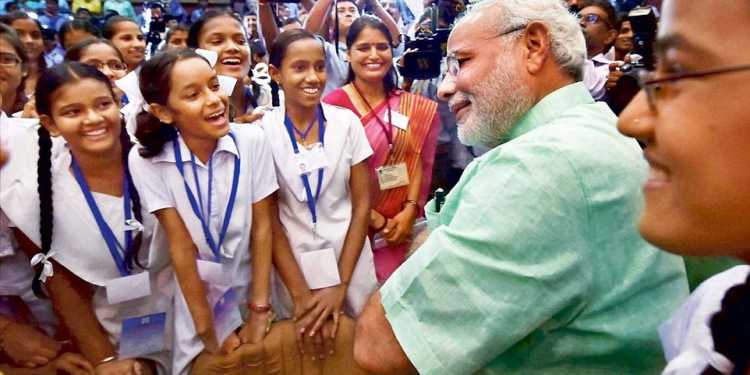As the government mulls over what changes should be brought into the education system in India and is in the process of formulating a new National Education Policy (NEP) even as commentators of various hues have gone into a frenzy discussing what should go in and what should be junked with a few alarmists predictably raising the bogey of “Saffronization” it is perhaps pertinent to recall that 2,800 years ago, circa 800 BC, a gigantic and grand University existed in a place called Takshashila (Takshila).
The ruins of Takshashila exist in present-day Pakistan but during its heyday this University housed more than 10,500 students and offered over 68 subjects spanning the Vedas, languages, grammar, philosophy, medicine, surgery, archery, politics, warfare, astronomy, accounts, commerce, documentation, music, and dance to name just a few. Master scholars like Kautilya, Panini, Jivak, and Vishnu Sharma were part of the faculty at this University teaching students from Babylon, Greece, Syria, and China.
The Nalanda University which flourished from 500 AD to 1,193 AD till it was razed by the Turks under Bakthyar Khilji even conducted an extremely difficult entrance examination that had a pass-rate of 3 out of 10 students! The Nalanda University transcended ethnic and national boundaries with students from China, Indonesia, Korea, Japan, Persia, and Turkey passing through its portals. When its Dharma Gunj (Mountain of knowledge) library was set ablaze it burned for several months – so huge was the collection of books and manuscripts.
Why is all this important? It is important because so few (even those in the area of policy making and governance) know about the rich educational, historical, and cultural heritage of our country.
Educational policies and pedagogy that do not take into consideration (a) the heritage and history of the land (b) instill pride in students of their rich heritage (c) frame policies that are rooted in the culture of the land but global in reach and outlook and (d) inculcate values and competencies that can help in nation building will only continue to perpetuate the inadequacies of past education policies.
PM Narendra Modi has set a deadline of end-2017 and the HRD minister Mr. Prakash Javadekar has his job cut out.
This is the first major policy overhaul since 1986 and the key question that needs to be answered is how will this education policy cater to the needs of over 300 million students across India?
The work for Mr. Javadekar and his deputy Mahendranath Pandey decidedly got more difficult as they have decided to junk the recommendations of the TSR Subramanian committee that was constituted during the tenure of earlier HRD minister Smriti Irani on the premise that these recommendations were a “mere compilation” of old reports. With Mr. Javadekar announcing that a new committee will be constituted to look into the changes to NEP it remains to be seen if the deadline will actually be met.
Although the fact remains that governments are well within their rights in accepting or rejecting recommendations the government would be well advised to not junk all of the recommendations of the TSR Subramanian committee. This is particularly important in the light of the fact that this government is already into its third year in office and cannot be seen to be vacillating on one of its key promises to its constituency. Constituting a new committee that will look into the recommendations afresh and come up with a new set of recommendations would mean that little to nothing would be implemented in this term of office and that would be truly an opportunity lost.
Below is a list of recommendations that the government needs to look at bringing into the education system at the earliest and with no further delay. Committees and white papers can always be prepared and revisions brought in later (if needed). Some though not all of these recommendations are also included in the TSR committee.
- Increase the outlay on education to a minimum 9% of GDP (presently it hovers around 3 to 4 %). This is more than the 6% outlay recommended by the TSR committee. Set aside at least 3% of this outlay towards “skilling” students rather than just providing education so that students become employable, self-sufficient, and entrepreneurial in their outlook.
- Incentivize the learning and teaching of Sanskrit. When the whole world is adopting the Sanskrit language, the step-motherly treatment given to this “mother” of all languages in the land of its birth is shameful. Sanskrit can truly become the link language and it will definitely not come with the baggage associated with Hindi. There is no Indian language that does not include words from Sanskrit or is not influenced by it. Knowledge of Sanskrit will also open up avenues of research and commentaries on our ancient literature by Indians and not by Western scholars often with vested interests and scant understanding of the underlying philosophy (barring a few exceptions). The government could setup a Sanskrit promotion and research council, funded by and under the Central Government that would oversee the promotion and dissemination of Sanskrit language and research into the ancient treatises. Include within this committee experts like Chamu Krishna Shastry and Dr. David Frawley to name just a few
- Standardize education curriculum and syllabi across the country to ensure equity and quality. This would ensure level playing field for all students particularly when students move from one state to another and also when they appear for national level examinations. At a minimum ensure common curricula for Science, Mathematics, and English.
- Setup a committee to go into the History and Culture curriculum with the objective of re-writing/revising textbooks to ensure the true history of India is told to children without any attempt at obfuscation or whitewashing Islamic and Colonial excesses and wanton destruction under the false pretext of unity and secularism. Not knowing the true history and realizing later that they have been fed a false narrative poses a greater danger to unity, brotherhood, and peace than telling children the unvarnished truth without of course making any attempt to inflame passions or divide community. Inputs from people like Rajiv Malhotra who are in the forefront of this battle would be crucial to this process.
- Setup a permanent education committee that works on updating and revising pedagogy to keep up with new developments and changes.
- Amend the RTE act to bring within its purview institutions run by minority communities as well and ensure uniform applicability of the EWS (Economic and Weaker Sections) criteria.
- Introduce procedural reforms that would do away with the mundane procedures of Transfer Certificates, Migration Certificates etc. to ease mobility and entry into schools across the country and at all levels.
- Introduce and make licensing and testing of all teachers in the government and private sectors at the entry-level and also at periodic time intervals to ensure teaching quality. Renewal of licenses and employment must be subject to certain minimum criteria determined on the basis of these tests.
- Cap the “no-detention” policy at the level of the fifth class but with the caveat that each student is allowed an opportunity of a second-chance at clearing the class within the same year so that he/she does not have to lose a year.
- Introduce and make compulsory pre-school education (Kindergarten) and training in government schools at the urban, semi-urban, rural, and anganwadi levels so as to ensure a level playing field for these children with those from private schools.
- Invest in technology and high quality technology-driven intelligent teaching systems across the board in government-run schools and colleges.
- Flatten educational opportunities by ruthlessly rooting out the practice of capitation fees and “seats for money”
- Enhance the number of government-run Universities per capita and also the per-capita intake across universities so that students who do not meet a narrow eligibility criteria but are capable otherwise, are not deprived and have the opportunity to pursue an education of their choice in a top-run university.
- Revise the reservation policy to ensure preferential allotment to only those from the poor and economically weaker sections irrespective of caste and community and not on the basis of caste alone as practiced now.
- Open up the higher education sector for top universities from across the world to setup their centers here and offer the same level of education and certification that would be applicable not only in India but across the globe and at a minimum in the home country of that particular university.
- Start the process of building capacity and infrastructure to increase the number of indigenous educational institutes and universities that are truly world class.
The time for this government to act is now without any further delay and/or indulging in meaningless exercises of constituting committee after committed. Now is as good a time as any.


































